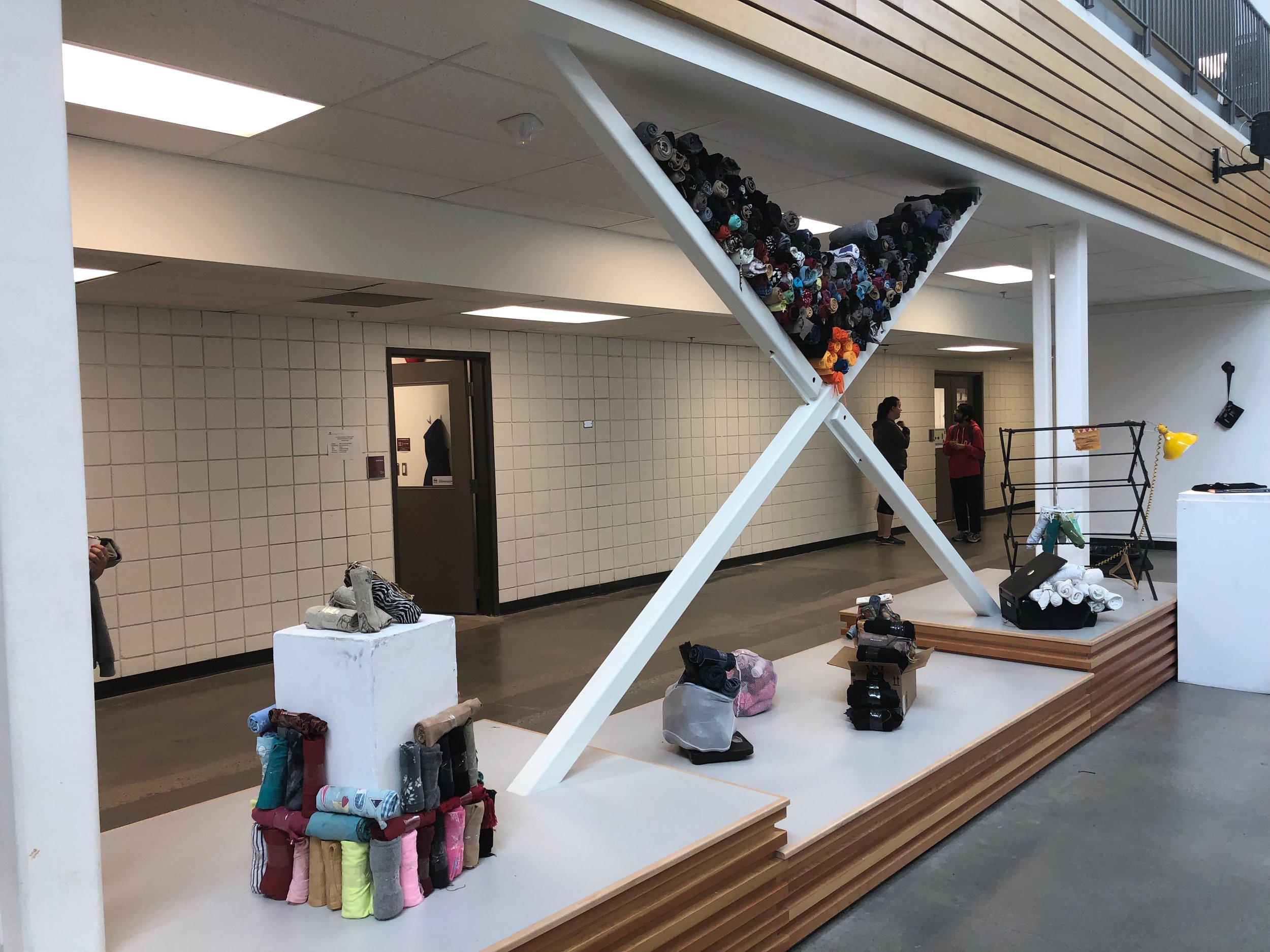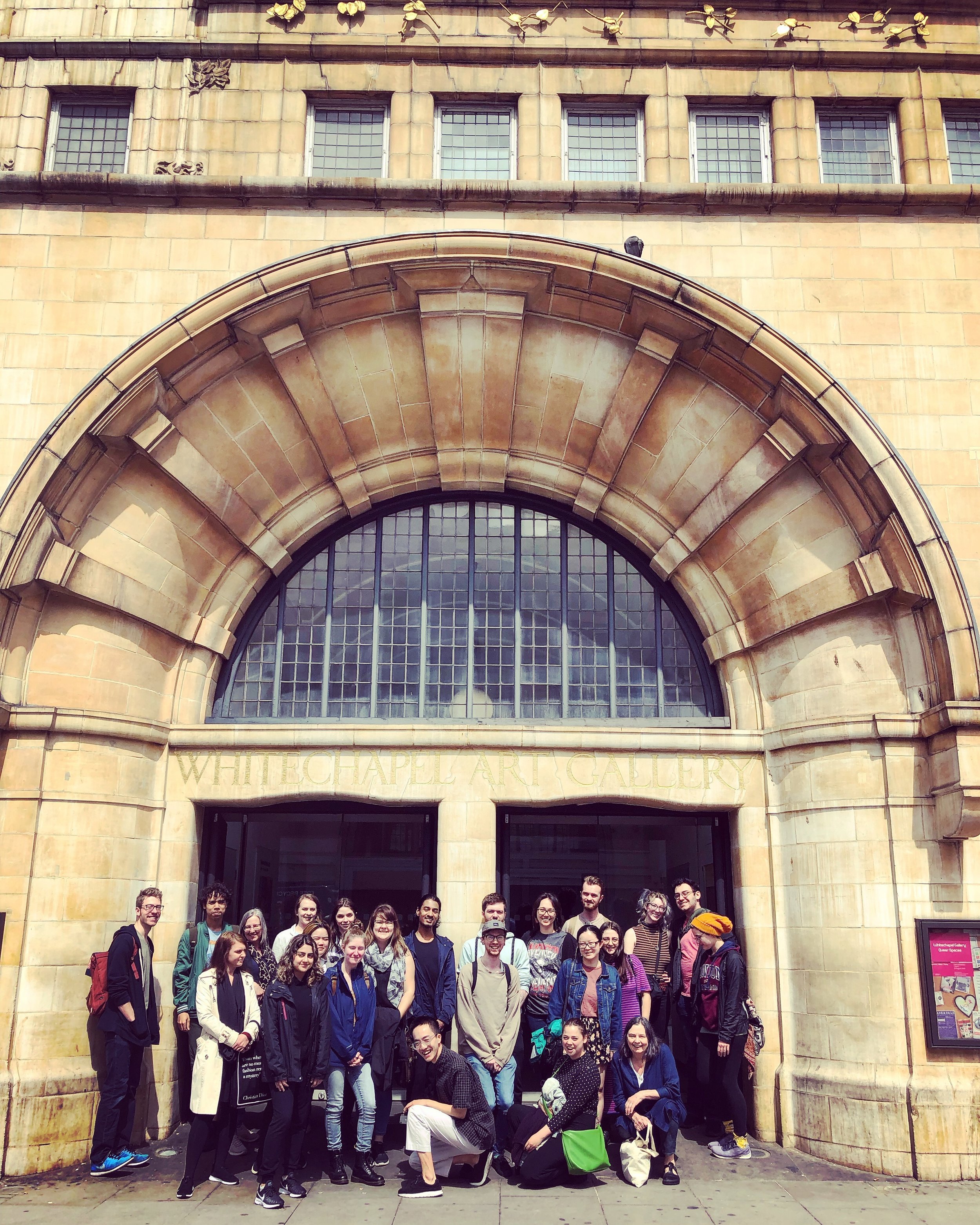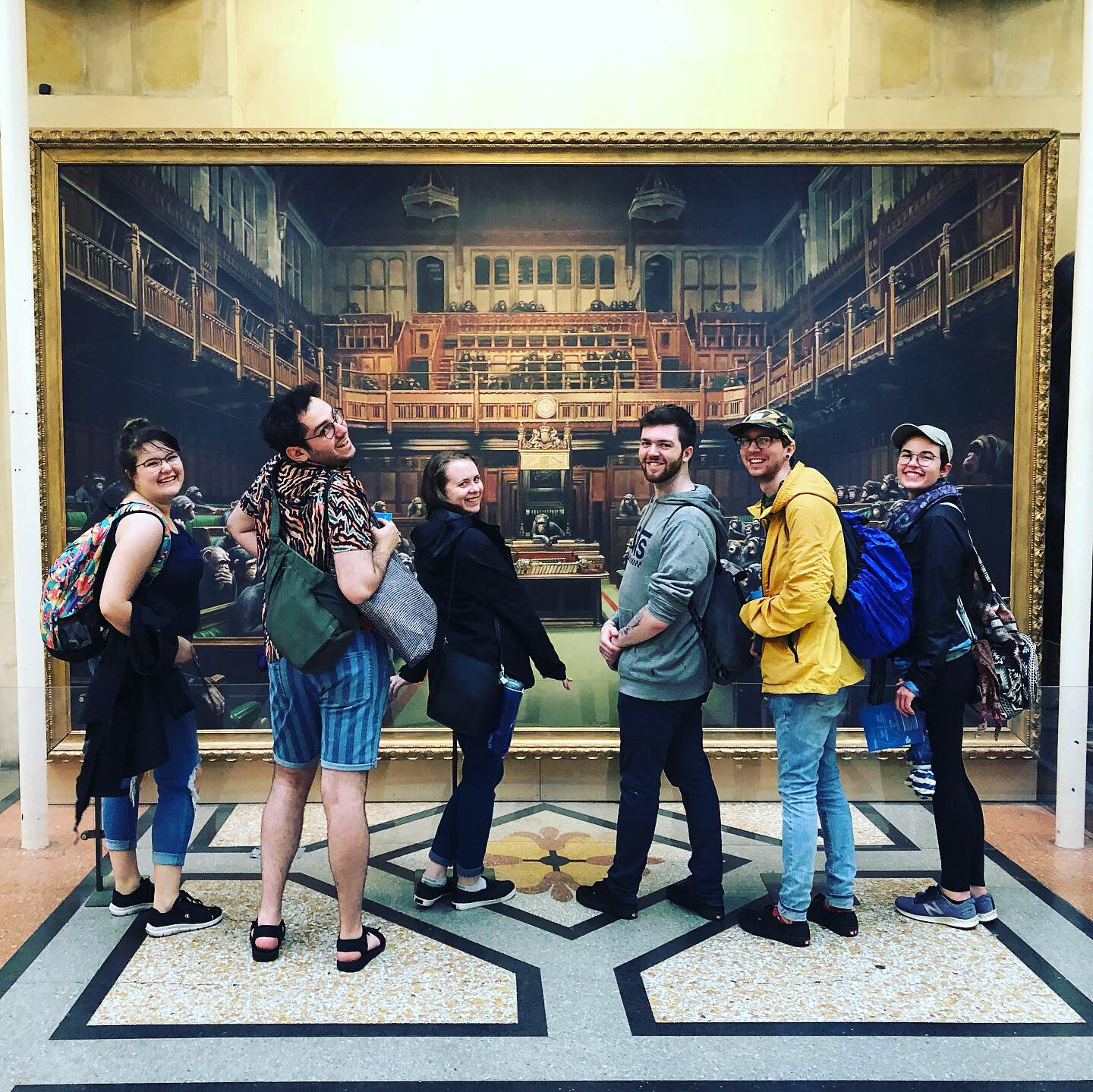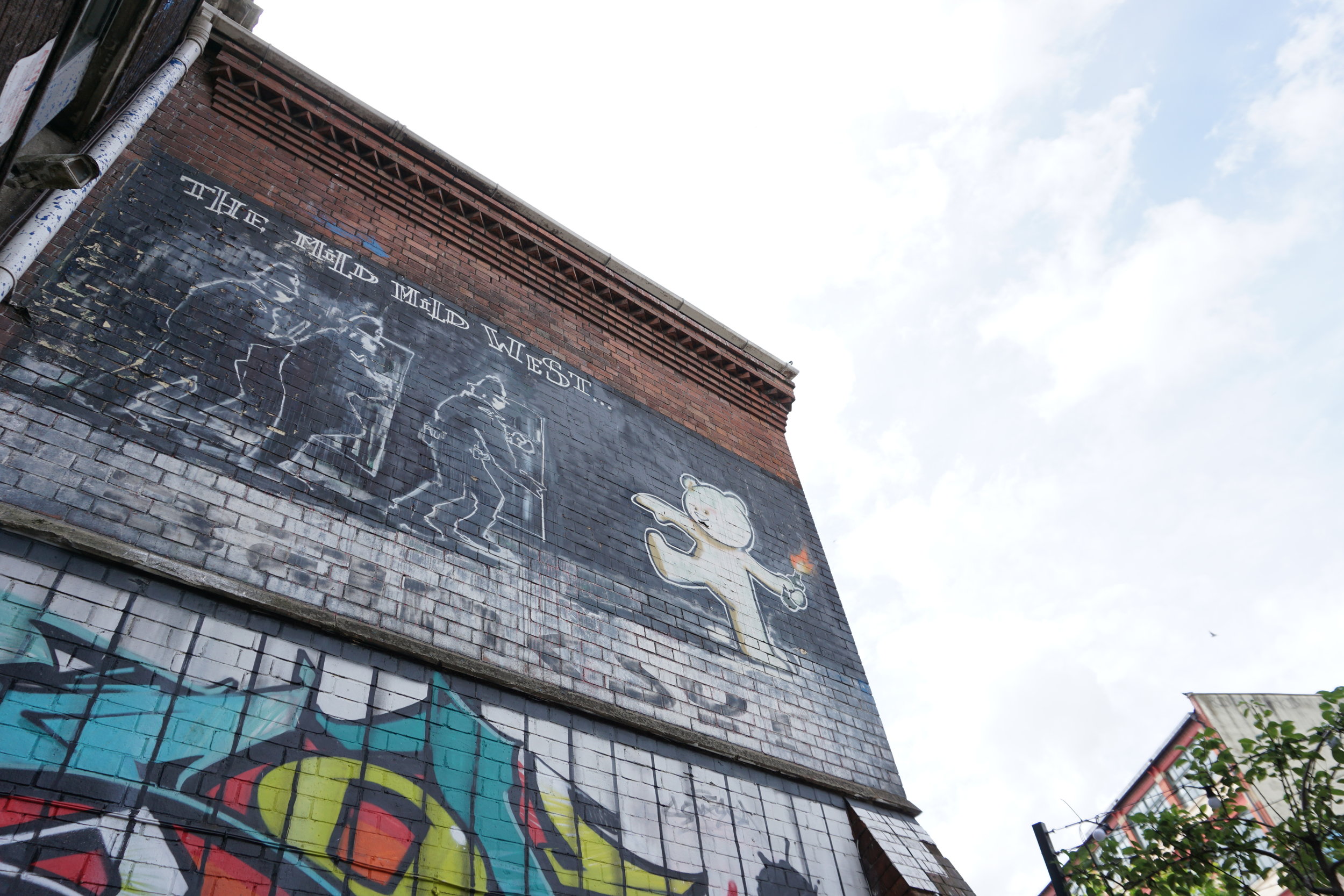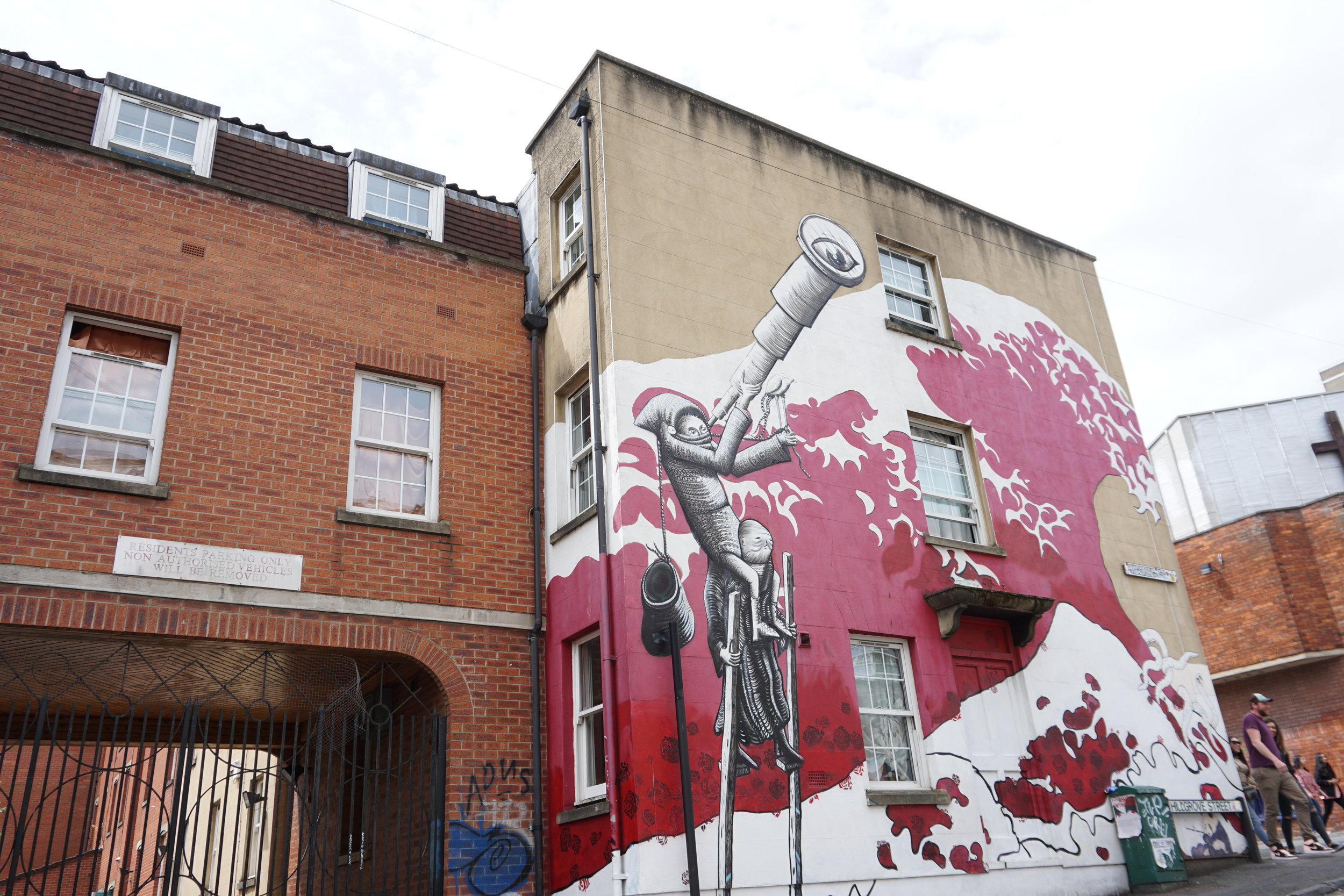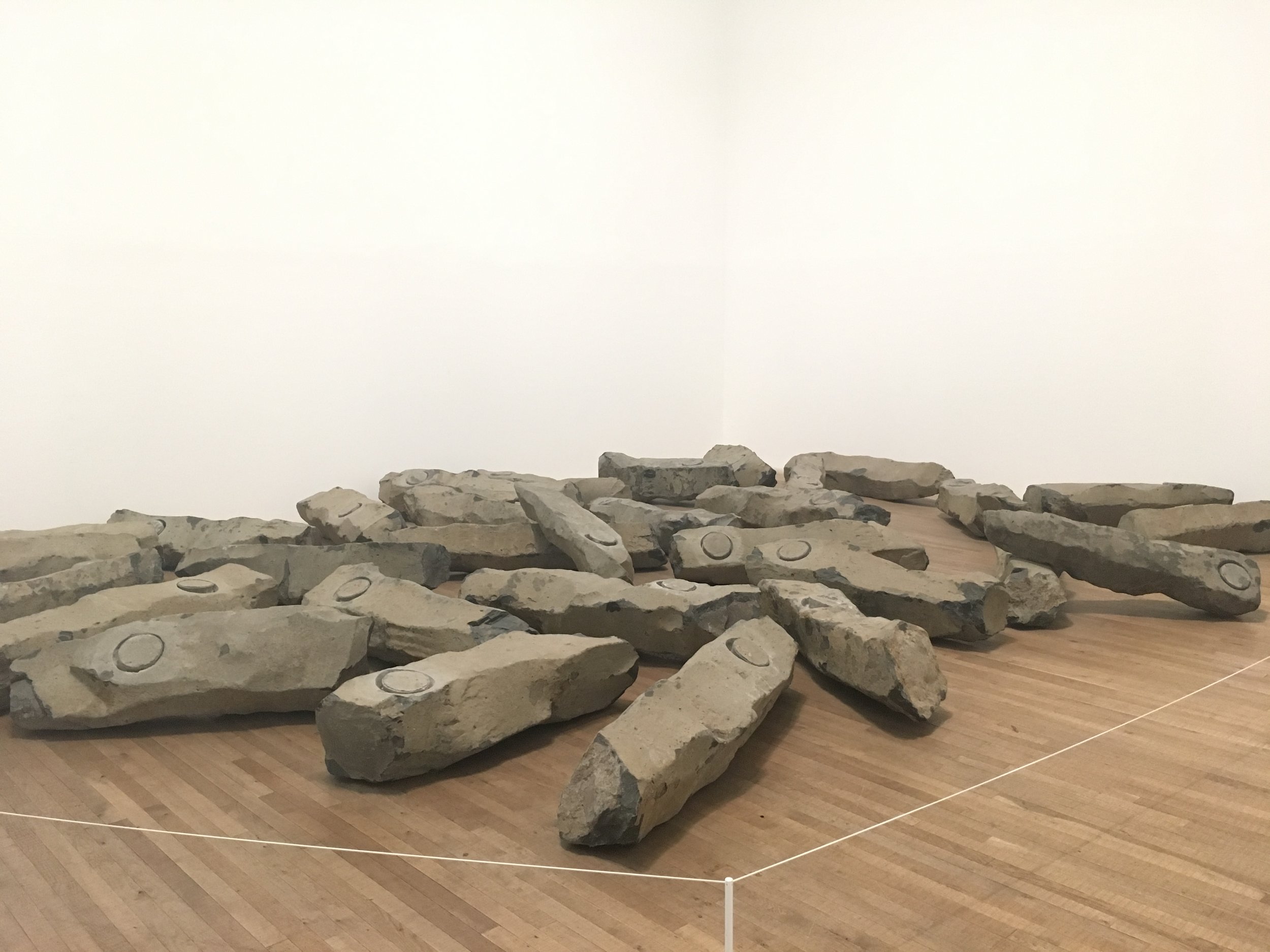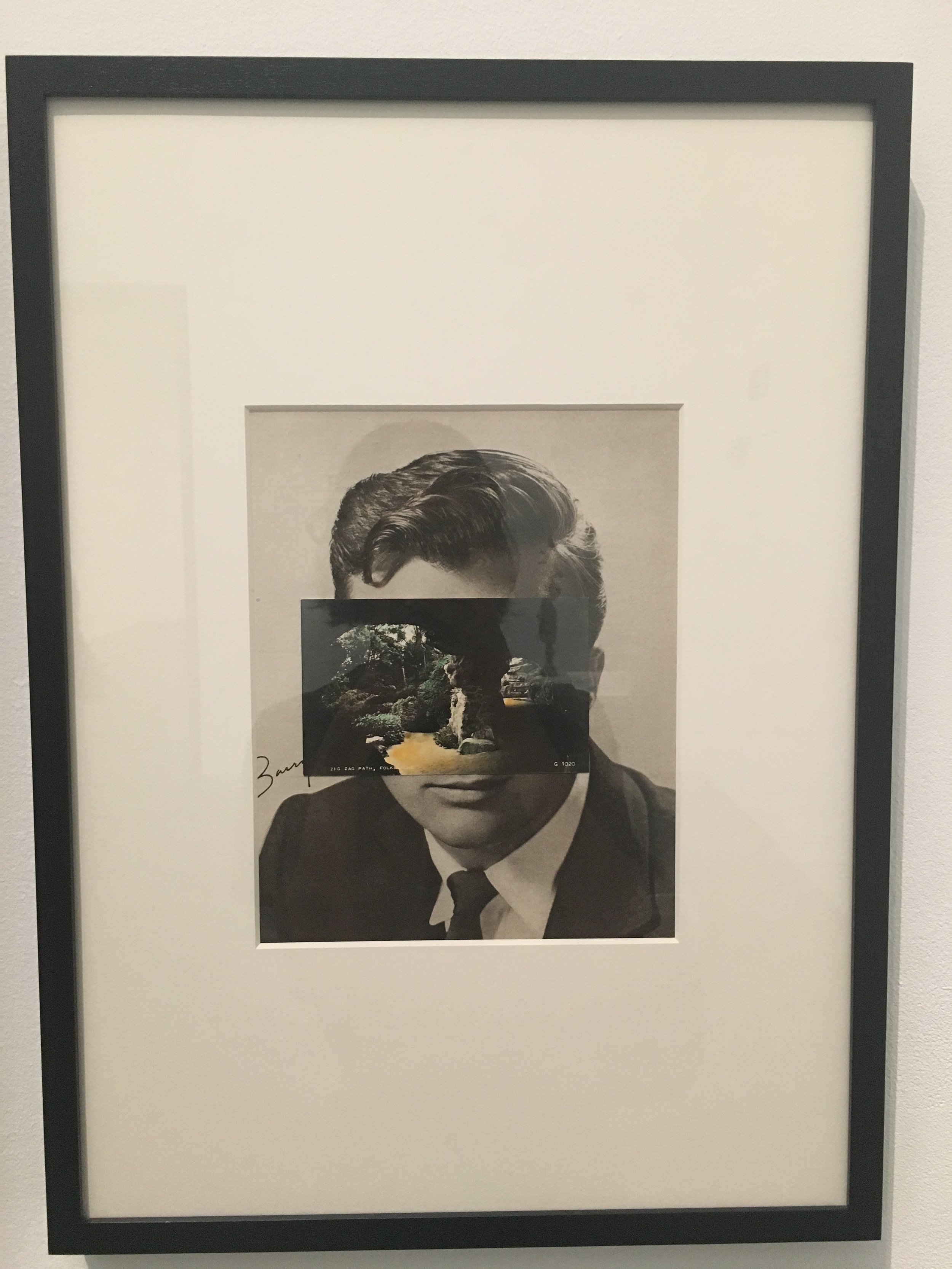Tell us a little bit about yourself—your background, major program of study, reasons for taking this trip, and anything else interesting you want to share (maybe something people might not know about you).
Hello everyone, I’m Angela Eszter Wells, a fourth-year Bachelor of Fine Arts student at Kwantlen Polytechnic University about to complete my final required course. Yes it’s one of the field school courses! As well, I have recently completed my Bachelor of Arts, major in Creative Writing at KPU.
Angela, a fourth year Fine Arts student and recent graduate of the Creative Writing BFA program at KPU, examines a painting with Shonel at one of many small London art galleries dotted throughout the city.
After attending the KPU New York/Venice field school in 2015, I decided to get an additional major in Fine Arts. My art practice focus is on painting and installation art. I started out at KPU studying Creative Writing and steadily gravitated toward visual arts through elective courses in art history and studio courses such as drawing and painting. Once again, I am at the crossroads of my education, to decide on whether to also pursue a graduate degree. The opportunity came up to participate in the KPU London/Venice 2019 field school and I felt it was arriving at the right time in my life to once again move me closer to a decision. In the past I have always considered art and writing as a hobby while I worked and raised my family. In the past five years my interests in the arts and my career decisions have finally aligned. Currently I am pursuing work in the arts and cultural sector plus working toward setting up my own studio practice. With a strong background in business entrepreneurship I hope to spend many productive years making a living from doing what I want-art and writing.
What has met or exceeded your expectations or surprised you about London (or Venice) so far?
London was not really on my travel list and now I’m wondering why it wasn’t. Art is readily accessible everywhere I look, even more so than New York. Admission to art galleries and museums is free. This is an art student’s paradise. I noticed that Londoners from every part of society are represented in the crowds that continually move through the galleries and museum spaces— from children in matching school uniforms to adults in runners and track pants carrying their groceries home from work. Whether dressed fashionably or not, people gather from all walks of life in London to enjoy art and culture of the Renaissance and earlier, onward through to the most contemporary artists working today. The thing that really surprised me the most about London is how efficiently everything operates—the metro, the cleanliness of the city and recycling efforts, the promotion and protection of the environment—which was especially great to see. And the wonderful manners and helpful attitude of Londoners across the city. This stood out for me—but equally as good was the experience of venturing out in the evening to the theatre or a restaurant, where even on a Tuesday night the city is vibrantly buzzing with energy, the streets filled with people enjoying themselves with music and theatre and restaurants, all while surrounded by beautiful historical architecture.
Give us some insight into your assigned artwork from the Tate Modern. After seeing the work in person in London (and any other related art from the same artist or art movement associated with the assigned work), what struck you most about it and/or how did the artwork’s form, content, and context shift for you when seeing it.
Who is my assigned artists at the Tate Modern?—British artist Yinka Shonibare with his work British Library (2014), and global artist Louise Bourgeois with her sculpture, Fillette (Sweeter Version) (1968-99). Both artists are known for their use of textiles in various sculptural and installation works, as well as their use of subversive humour and explorations of political discourse around gender, assimilation and immigration, family, society, and the psyche. To focus on Shonibare’s work, British Library, viewing it in person exceeded my expectation of the two-dimensional photo I studied before arriving. From the photo image I formed a very narrow understanding of the ideas of identity that Shonibare was working with. What really makes this piece work for me is the way it is activated when you find yourself standing within the centre of it.
Angela sitting and enjoying her assigned artist’s installation at Tate Modern— Yinka Shonibare’s British Library (2014)
At this level of engagement, it becomes an immersive experience both visually and intellectually. When I first entered the room, which was taken up entirely by the work on three walls, I was struck by the meticulous handling of the fabric covered books. The bright colours and patterns drew me in. The seating and familiar iPad screens made me want to linger and read. The prints on the fabric covers speak to a culture other than British, yet the content around the immigrant contribution to British culture drew these polarities closer. Then the experience became even more personal—of the many immigrants, their cultures represented by a multitude of different names. I was glad to see Hungary, the country of my heritage, listed. This was my connection into the piece, the birthplace of my parents embodied in the distinctly Hungarian names. The exhibit was very accessible, and I felt comfortable sitting for quite some time to make a deep dive into the available data, as well as the spontaneous conversations that started up between myself and others while I sat there. I felt not at all like I was in a museum as the exhibit transported me to a place made for conversation and looking—and lingering. This was a place to exchange ideas and for this reason the piece effectively embodied the artist’s ideas around the contribution of immigrants to British society.
How did you approach the creative task of responding to your assigned artists in studio? What were your challenges as an artist to be in dialogue with the artwork and artist? Would you do anything differently now that you have seen the work in person?
My response to my assigned artists was to explore ways in which fabric can be used to create art that speaks for me (see images of projects below). In my opinion there is a visual language in the specific placement of colour and texture, such as with my final project of red pink mauve rolls of fabric which were used to create the visual effect of a vagina crowded in and surrounded by darker fabric cut from men’s clothing. I feel it is an image that expresses my deep concerns for politically driven disruptions of long-standing laws in America regarding women’s rights and abortion— changes I never expected to see in my lifetime. I think the biggest challenge for me as an artist, when asked to respond to an artwork, is that I tend to focus more on the formal aspects of an artist’s work rather than the content or context. I see colours, textures and the physical nature as being far more accessible to respond to than the ephemeral and contingent nature of context. I look for concrete elements of a work. The use of fabric resonates with me but rather than explore identity constructs as Shonibare does, I chose to use the fabric as a colour palette to express my own personal thoughts and concerns in response to current world events.
Now that I’ve seen the works of my assigned artists in person I would have thought more about the space around my work and may have chosen to make an exploration around cultural identity and explored my own contribution to Canadian culture as a first generation Canadian of Hungarian descent. I think both artists use the title to subvert the visual elements in their work. I may have looked more closely at representing my immigrant past juxtaposed with Canadian colonial identity within Canada. If I followed this idea I may not have chosen to work with the fabric rolls or with colour since I chose the medium before the idea, I feel I restricted myself from fully engaging in a response to my assigned artists.
Today’s activity was located at the Whitechapel Gallery and Barbican Arts Centre. What were your impressions? What will you take away of the experiences of this day? What are the most memorable moments for you?
Today’s activity was a tour of Whitechapel Gallery and the performing arts centre, Barbican. My day began with an unplanned trip to Balthazar for a fabulous breakfast with a fellow classmate as we both happened to arrive at the same time in the lobby of the Generator. Timing is everything in a hostel. Whitechapel Gallery is a space dedicated to emerging artists, performance, talks, films, and events with a focus on arts and culture within the diverse communities of London. It’s important to note that there is no permanent collection here, and that the spaces are available for a rotation of exhibitions and artist throughout the year. The exhibition by Michael Rakowitz had an entrance fee attached and I did not attend. There were other exhibits to check out including an interesting archive work titled Queer Spaces: London, 1980s - Today, which chronicled the closures of several clubs and venues serving LGBTQ communities in London since the 80s. This archival work was thoughtfully curated with a rich collection of letters, photographs, and other memorabilia to provide a reflection on LGBTQ history in London.
Anglea, pictured fourth from the left, with the group at the famed Whitechapel Gallery— an art space dedicated to the exhibition of the latest in cutting edge, non-traditional, and global avant-garde art.
The second floor space was curated with select works from the “la Caixa” Collection of Contemporary Art by Maria Fusco and included video/audio work, installation, sculpture, and photography. There was an interesting and diverse selection of art which was held together by the common theme of bridging cultures through language, sound, music and movement. Though each work occupied the same gallery space, individual works such as the concrete and steel arch by Christina Iglesias (1956) also felt isolated from the broader theme. In my opinion this gallery is best approached as an eclectic combination of political and cultural histories represented by the works of emerging and experimental artist and curators.
Angela in kinetic conversation with an art object at Whitechapel Gallery.
My impressions of the “AI: more than human” exhibit at Barbican start with the basic observation that it was not focused on art in anyway. It was more of a historical view of the development of AI and relied heavily on video and audio from the movie industry. I noticed examples of robot toys from Sony Corp. dating back to the 90s. Most of the interactive technologies were basically recycled from exhibits that I have seen over the past 20 years. I was expecting to see works that explored ‘deep learning’ whereby AI makes autonomous decisions. There was no successful display that reflected the current advances in machine learning. A note about the curation— it was lacking in that displays were poorly lit, and the odd use of props and curtains made the space seem quite claustrophobic. The highlight of the exhibit was the interactive piece at the main entrance which was irresistible to some and entertaining to watch for others. The take away for me from the day’s events is to think about how an exhibit is curated. I liked to see that galleries such as Whitechapel continue to make space for more experimental types of work within a major art centre like London. I have seen some fantastic examples of curation over the past week, such as the exhibition at White Cube Gallery with works by Sarah Morris and Zhou Li. Experimental and emerging artists and archival work represent distinct challenges for a curator. I really felt that the gallery tours today gave me a chance to appreciate different approaches to these materials and non-traditional mediums.
Anglea, at far right, and the group enjoying an outing in Shoreditch not far from Whitechapel and Barbican.

